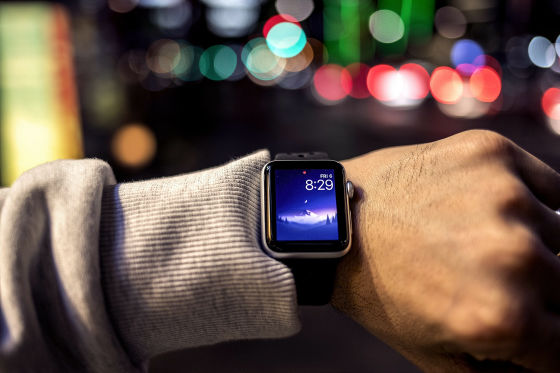Controlling heart rate variability (HRV) with respiration makes it more resistant to stress

byGiulia Bertelli
Heart rate variability means that the distance between the pulse and the pulse is shortened or lengthened. If the heart rate is high, such as tension, the heart rate variance is small, and conversely, if you are relaxed it will be more. It is said that if the heart rate variability is high, exercise performance will rise and it will be strong against stress as well, but with the advent of wearable terminals management of heart rate variability, eventually stress control can be done in a visible form I am coming.
What's Your Heart-Rate Variability? It May Be Time to Find Out - WSJ
https://www.wsj.com/articles/whats-your-heart-rate-variability-it-may-be-time-to-find-out-1498442460
People's heart beat is irregular, the distance between pulse and pulse is always short and long. This fluctuation of fluctuation is called "Heart Rate Variability / HRV", and when using a wearable device such as Apple Watch which can acquire HRV data by pulsing, the resting time and exercise It is possible to see how the heart rate changes at the time of recovery / recovery after exercise.

byDaniel Lee
Previous studies have shown that performance in exercise can be improved by controlling heart rate variability, and among the athletes, there are also many people performing maintenance by measuring HRV using a wearable device It exists. It is a trainer and an athlete of triathlonIñaki de la ParraMr. HRV measured that he was able to shorten the time by 5 hours from Ultraman triathlon in the past and completed swimming 10 km, bike race 420 km, marathon 100 km in 22 hours 34 minutes.
Meanwhile, collecting HRV data has advantages not only for athletes but also for the general public. It is because there is a view that controlling HRV becomes more resistant to stress.
The reason why the heart rhythm of a person changes is that the heart beat of a person is called a sympathetic nervous system and a parasympathetic nervous systemAutonomic nervous systemBecause it is influenced by the two pillars of. The autonomic nervous system controls irregular functions such as breathing, digestion, perspiration, and body temperature adjustment besides heartbeat. According to Lawrence Creswell of cardiac surgeon, "The sympathetic nervous system is related to the flow of adrenaline and activates the beating of the heart, while the parasympathetic nervous system plays a role of braking the heart beat," , Both play a role of the relationship between accelerator and brake.

byDenisenFamily
While people live, the balance between the sympathetic and parasympathetic nervous systems is constantly changing, for example, the parasympathetic nervous system dominates because the body needs rest after intense exercise. And when the body rested as much as needed, this time the sympathetic nervous system worked better, the body changed to prepare for further exercise. Looking at this flow with HRV, HRV gradually goes down after the exercise, and gradually HRV will go up as soon as you get rest. The fact that HRV is small means that the body is under stress, and if you do intense training during this time you will suffer physical damage. This is why, in sports training, the heaviest training is done when the HRV after recovery is the largest.

Professor Richard Giberts who studies health psychology at Alliant International University believes that raising HRV will help treat anxiety and stress related diseases and developed a program to raise HRV with slow and orderly breathing Did. The way to "take a deep breath" when you are nervous is common, but caused by stressIrritable bowel syndromeBreath control is available as a way to deal with. Researchers are watching that it is possible to increase HRV by breathing slowly and rhythmically, lowering blood pressure and reducing anxiety and stress.
Professor Gibberts collaborated with Professor Paul Raeler of Rutgers University in 2014 and with HRVBio feedbackWe announced the research of. In this study, the reason why HRV biofeedback occurred was examined, and it was reconfirmed that abdominal breathing moving the diaphragm is part of biofeedback. According to Gibberts et al., The abdominal respiration stimulates the relaxation reaction in the parasympathetic nervous system and the vagal tone is relaxed. Also, this study shows that people with high HRV have low biomarkers of stress, high spiritual and physical resilience, and good cognitive abilities.
Frontiers | Heart rate variability biofeedback: how and why does it work? | Psychology
https://www.frontiersin.org/articles/10.3389/fpsyg.2014.00756/full
In addition, the US Navy also adopts the "Box Breathing" respiration method that repeats regular breathing for the purpose of relieving stress.
Breathing method "Box Breathing" to relieve stress, Adopted Navy SEALs of US Navy special forces - GIGAZINE

According to Professor Gibbarts, there are differences from previous studies from previous studies, but when HRV is the most gentle state, it is known that the number of breaths per minute is about 5 to 7 times . Also, when breathing performed in 1 minute can be kept in the range of 5 to 7 times, the average value of HRV is likely to increase by 25%. In May 2017, research contents that HRV biofeedback training relates to stress and anxiety has also been announced.
The effect of heart rate variability biofeedback training on stress and anxiety: a meta-analysis. - PubMed - NCBI
https://www.ncbi.nlm.nih.gov/pubmed/28478782
The height difference of HRV is person, and it is said that it is difficult to decide HRV unless it monitors HRV for about a month, but it is difficult to decide where the baseline of your recovery status is, but to improve breathing and increase HRV Applications aimed at are gradually increasing. According to experts, it is said that benefits can be obtained by practicing breathing for 20 minutes a day.
Related Posts:
in Science, Posted by darkhorse_log







